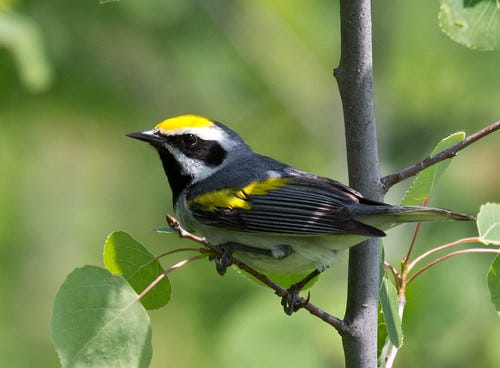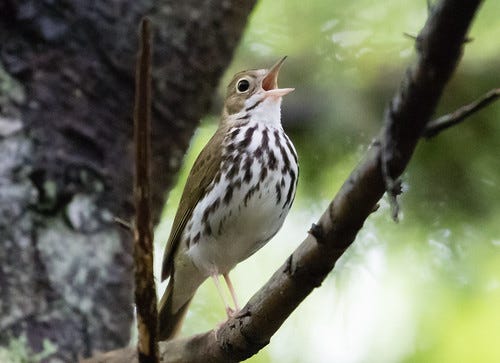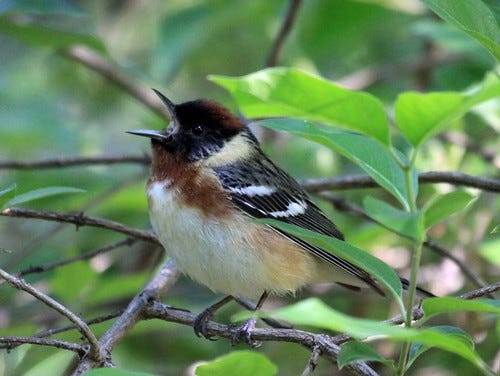Warblers!
For the first time ever, the American Birding Association named a warbler its Bird of the Year.
(Listen to the radio version here.)
On January 2, the American Birding Association revealed the 2024 Bird of the Year: the Golden-winged Warbler. I’m of course delighted—I happen to live in the very state, Minnesota, with the highest remaining density of Golden-winged Warblers in the known universe. About half the global population nests here.
Of the 14 species who have been given the ABA honor since the “Bird of the Year” program started in 2011, this is the first warbler with that distinction. Our wood warblers, belonging to the large family Parulidae, are beautiful, dainty birds unique to the Americas. The family has 115 species spread between North, Central, and South America and the Caribbean—56 species can be found in the United States and Canada, with 31 breeding in Minnesota. Over the years I’ve lived here, I’ve seen 27 different warbler species in my own backyard in Duluth.
Despite their being rather common birds from spring to fall, and despite how intensely colorful several common ones are, a great many people have never seen, or at least recognized, a warbler. In my yard, several species occasionally visit bird baths set on the ground, especially in late summer and early fall. In quality habitat where they breed, warblers may visit birdbaths even during nesting season!
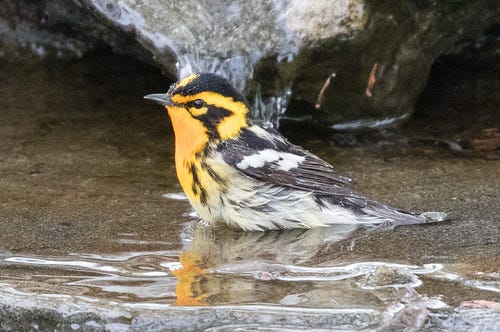
Very rarely, some warblers visit feeders during extreme weather during migration, too.
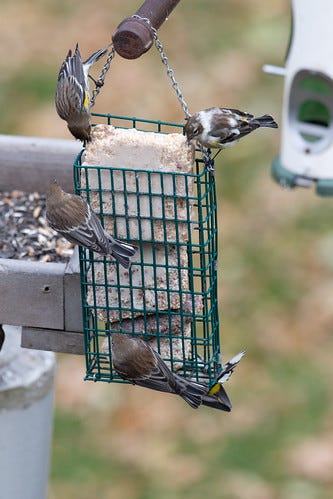

Except during migration, warblers usually keep to themselves. Some sing a lot during spring migration, but they tend to sing from trees, often very high up, and most of their songs aren’t as loud and insistent as easier-to-see robins and orioles, so it’s easy to tune them out. The Ovenbird is an exception, its song both loud and insistent, but a nearby Ovenbird can be shockingly difficult to pick out even as it belts out its song not far above eye level.
A handful of warbler species winter in southern and central states, and sometimes an outlier even appears in the north. This January 3, Scott Wolff saw a shockingly late Palm Warbler on Park Point in Duluth. But even people in the south get hungry for the huge numbers that will surge through come spring. In the same way that northern gardeners pore over pages of garden catalogs in January and February, I look through my warbler photos, listen to my backyard recordings of spring birds, and make plans for getting better photos and recordings this spring.
Beyond their intrinsic value and self-evident right to exist, warblers have enormous value to us humans. Like many neotropical migrants, warblers feed voraciously on insects, including species that are extremely harmful to our economic interests.
Just one handsome little species, the Bay-breasted Warbler, can consume over 13,000 budworms per hectare (about 2.5 acres) in just 41 days. Tennessee and Cape May Warblers also specialize on the budworms, each species picking off ones in its own separate niche, so all three species can thrive in the exact same area, feeding in the same trees. All belong in a healthy ecosystem.
Millions of dollars of pesticides have been sprayed on forests to control spruce budworm with little short-term and no long-term benefit. Forest management is complex, but we know for sure that healthy warbler populations are entirely beneficial, and not just those that specialize on spruce budworm. Spring warbler migration tracks the first leaf-out, right as tiny caterpillars are hatching to feed on emerging leaves while the cell walls are still developing and digestible for tiny grubs. Warblers take a huge number out before they can do any serious damage, without compensation and without causing any damage to anything except the insects they feed on.
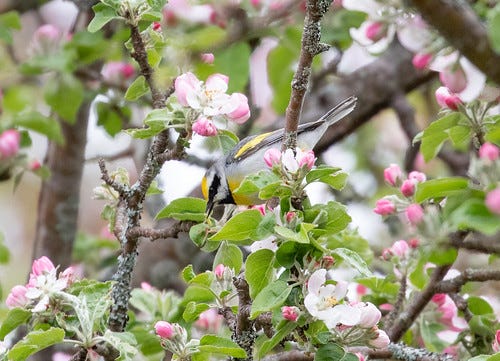
Putting a monetary value on warblers, many weighing less than two quarters and none who have the slightest interest in money anyway, makes no sense. We birders derive an immeasurable amount of joy during and beyond the moments our lives intersect with warblers—a joy that even extends to winter days when we’re merely anticipating the moments to come when our lives will intersect with warblers. I’m thrilled that the American Birding Association named a warbler as its 2024 Bird of the Year. Next time I’ll focus on that stunning little jewel.





